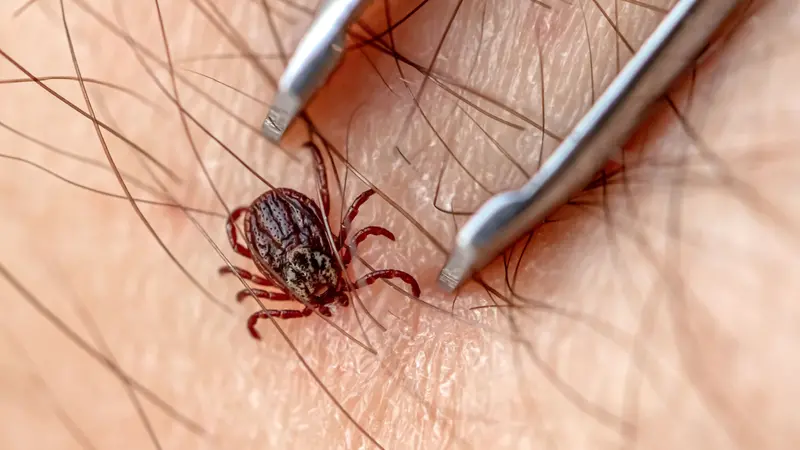

WELLthier Living and Aging

WELLthier Living and Aging
An Uptick in Ticks
Warm weather might make you want to get outdoors and enjoy walks in the woods, picnics, gardening, and more. But tiny ticks also emerge when temperatures rise and they can take a big bite out of warm-weather fun.
Bites from infected ticks are responsible for about a half-million new illnesses each year in the U.S.—and those numbers are rising. Lyme disease is by far the most common. It accounts for more than 80% of tickborne illnesses nationwide. Other tick-related diseases include babesiosis, tularemia, and anaplasmosis. Symptoms of these infections can range from mild rashes and discomfort to long-lasting health problems to a severe allergy to red meat.
There is good news though—you can take steps to keep ticks from making you sick and scientists are looking for better ways to diagnose, treat, and prevent tick-related illnesses.
Risks From Ticks
The chance that you’ll get sick from an infected tick mostly depends on where you live. Different types of ticks live in different parts of the country. Each type can pass on the germs that cause different diseases. Nationwide, more than 17 human diseases are known to be caused by at least nine kinds of ticks. And all these ticks are moving into new regions.
“As the climate warms and changes, it’s likely that we’ll see more tickborne diseases in more locations,” says Dr. Erol Fikrig, an expert in tick-related diseases at Yale University. He and his colleagues are working to better understand the relationships between ticks, the germs they carry, and the animals they infect.
Ticks might seem easy to avoid. They can’t fly or jump. But they can detect heat, breath, and other signals from warm-blooded creatures. Ticks need blood to develop and to produce eggs. To find meals, they often cling to the tips of grass blades or leaves with their back legs. They wave their front legs if they sense that you or another potential victim is nearby. If you brush against a tick, it can climb on and look for a patch of skin to bite.
Once a tick digs into the skin and starts sucking blood, any germs it carries can enter its victim. But it can take a couple of hours for a tick to choose a spot and begin feeding.
“If you catch and remove a tick early, and it has not yet taken a full blood meal, your chance of getting an infection is greatly reduced,” Fikrig says. If you don’t remove a tick, it can stay attached for several days. As it slowly fills with blood, the tick may swell in size by 10 times or more.
All known tickborne diseases can cause fever. Other common symptoms include headache, fatigue, and achy muscles. Some diseases can cause distinctive rashes. Lyme disease, for example, often causes an expanding rash that looks like a bull’s-eye. Ehrlichiosis, tularemia, and Rocky Mountain spotted fever can also cause rashes.
Unusual Meat Allergy
Most tick-related illnesses are caused by infections. But over a decade ago, NIH-supported researchers found that certain tick bites might instead lead to a food allergy. The condition is called alpha-gal syndrome (AGS). The allergy is to a sugar molecule called alpha-gal that is found in red meat.
“This includes beef, pork, lamb, venison, rabbit, and even the products from these animals, such as milk and dairy,” says Dr. Scott Commins, an allergist at the University of North Carolina. He worked with the research team that identified the link between red meat allergy and the bite of the lone star tick.
“AGS can cause hives, itching, swelling, shortness of breath, or gastrointestinal distress after eating red meat,” Commins says. AGS can sometimes lead to a severe allergic reaction called anaphylaxis, which can be deadly without emergency care. Affected people must avoid eating red meats.
Most food allergies cause symptoms several minutes after eating. But AGS symptoms tend to appear three to six hours after eating red meat. This delayed reaction can make it hard to realize that red meat is to blame. Scientists don’t yet understand how the bite of a tick can lead to this allergy.
AGS is relatively rare, but its numbers are rising as the lone star tick spreads to new areas. Today, this tick is found widely from Texas to New England.
“On a positive note, there’s pretty good evidence that over time, the allergy can go away in some people,” Commins says. “We think that avoiding tick bites is key.” A simple blood test can show whether a person still has AGS.
Blocking Tickborne Illness
Even though tick-related diseases are becoming more common, you can still enjoy the outdoors if you take some precautions.
“You don’t need to be afraid of ticks,” says Dr. Sam Telford, a tick disease researcher at Tufts University. “Depending on where you live, most tick bites don’t necessarily carry an infection. And even if they do, if you remove the tick promptly—by taking a shower, feeling for ticks, or looking for them—you will greatly reduce your risk.”
To provide even more protection, NIH supports several lines of research that aim to block tick-related illness. Telford and colleagues are focused on stopping the spread of tickborne infections in the wild. They’re testing different ways to keep the disease-causing germs from infecting small creatures that ticks love to bite, like mice.
“The idea is that if you target mice, they will no longer pass infections to ticks. And then presumably there will be fewer infected ticks in the environment to infect humans,” Telford explains.
Fikrig and colleagues are working to create a new type of vaccine that keeps ticks from attaching to the skin long enough to transmit disease-causing germs. Their experimental vaccine has been shown to prevent Lyme disease in animals. They are testing to see if this approach can block other types of tickborne infections.
Fikrig notes that many tick-related diseases can be effectively treated if caught early. “If you’ve been in an area where ticks are common and you develop a fever, it’s possible that you had a tick bite but just didn’t realize it,” he says. “You should seek medical attention to get advice. Early medical attention is always the best.”
Block Tick Bites
When outside:
- Treat clothing and gear with products containing permethrin.
- Use insect repellents as directed. Find effective ones from the EPA.
- Avoid areas where ticks hide, including high grass and leaf litter.
When back indoors:
- Change your clothes when you come inside. Wash the clothes you used outdoors in hot water.
- Check your whole body for ticks. Ticks can be as small as a poppy seed. Remove ticks with tweezers. Pull upward with steady, even pressure.
- Shower within two hours after coming indoors, to wash away ticks before they latch on.
REFERENCES
National Institutes of Health. (2023, June). An uptick in ticks. NIH News in Health. https://newsinhealth.nih.gov/2023/06/uptick-ticks


 By
By







